Outreach
Using ELISA Assays to Track Disease Outbreaks
March 2018
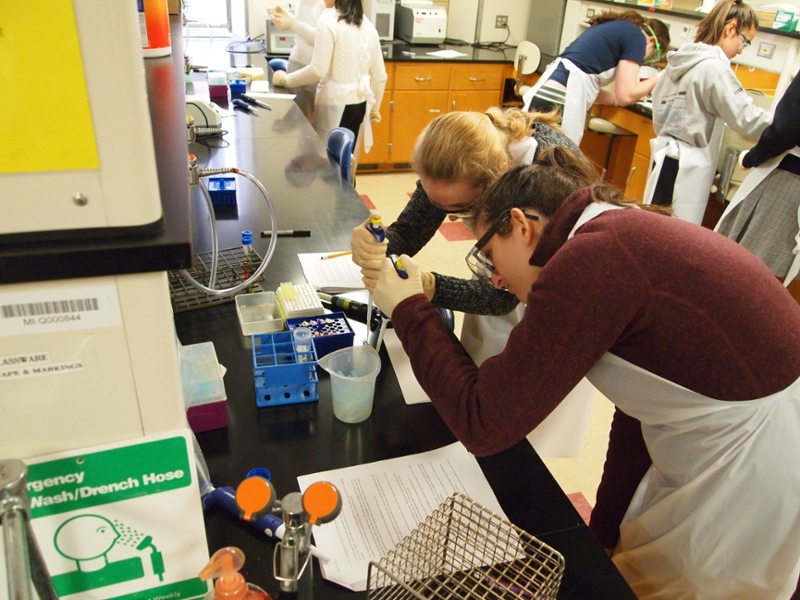
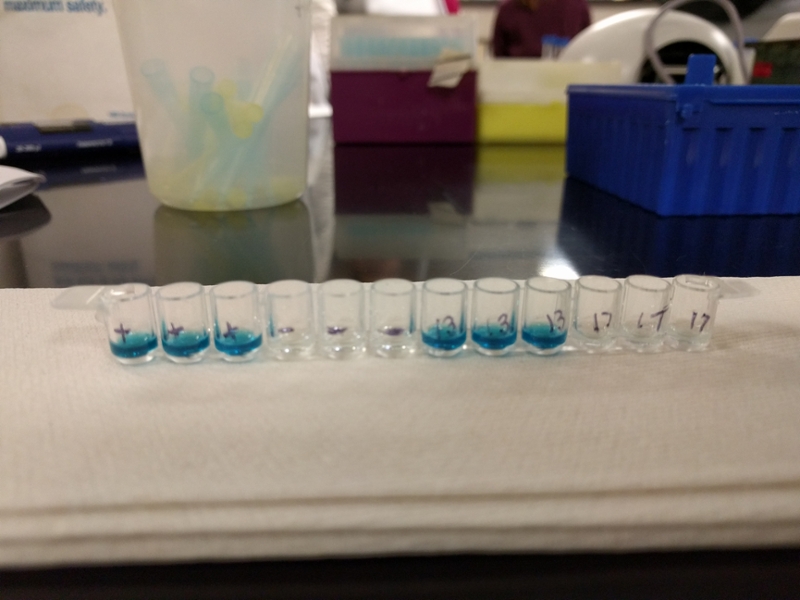
On March 20th and 23rd, 2018, the Department of Biological Sciences Outreach Program hosted 70 high school students to perform an ELISA (Enzyme Linked ImmunoSorbent Assay) Experiment. Students came from North Allegheny, Oakland Catholic, Serra Catholic, and Ellwood City High Schools. Students were given an introduction to the ELISA assay, including topics of how antibodies work, and how ELISAs are used in science, by Dr. Natalie McGuier. She challenged the students to learn the biological role of antibodies in the immune system, and to investigate common ELISA assays that can be purchased at your local drug store. The students were then broken into smaller groups to carry out the experiment in the Biology Undergraduate Laboratories. The high school students were mentored by undergraduate and graduate teaching assistants from MCS.
Students were instructed on sterile lab technique before working at the lab bench. The students tracked a SIMULATED disease outbreak. They performed an ELISA or enzyme linked immunosorbent assay to determine if they had been exposed to a contagious “disease”. The ELISA uses antibodies to detect the presence of a protein (antigen). The day ended with the students summarizing their ELISA results, and tracked the disease outbreak back to its original source. The instructors emphasized the importance of the use of ELISA assays in medical and scientific applications.
Dr. Carrie Doonan coordinated the experiment. Dr. McGuier provided the Introductory Lecture. Lead Instructors were Dr.Meredyth Wegener, Dr. Emily Drill, and Dr. Natalie McGuier. Undergraduate MCS teaching assistants were: Rahin Chowdhury, Noelle Toong, Fred Mun, Alan Hsu, Brenda Xiao, Michael Young, Roosha Mandal, Hunter Kready, Kathryn Hanson, Hyun Park, Meera Krishna, Pedro Safi, Kiran Mirpuri, Julia Carter, Aliya Saffran, Maxwell Martin, Jacqueline Hon, Jamie Chan, Jessica Jue, Sophie Halpern, Odelia Cheng, Serena Lee, Sarah Klotz, Victoria Lee, Kathryn Bregna, Ona Ichoku, Ling Xu and Hal Chen. Biology Graduate Student Teaching Assistants were: Ian Fucci, Katie Lagree, Roni Lahr and Nathaniel Williams. Participating High School teachers were Cara DeSalvo, Serra Catholic, Sherri Fowler, North Allegheny, Jonica Walters and Jody Christopher, Ellwood City, and Melissa Kavanshansky, Oakland Catholic.
View more photos from the event on our departmental Flickr.
Making Glow in the Dark Bacteria
November 2017
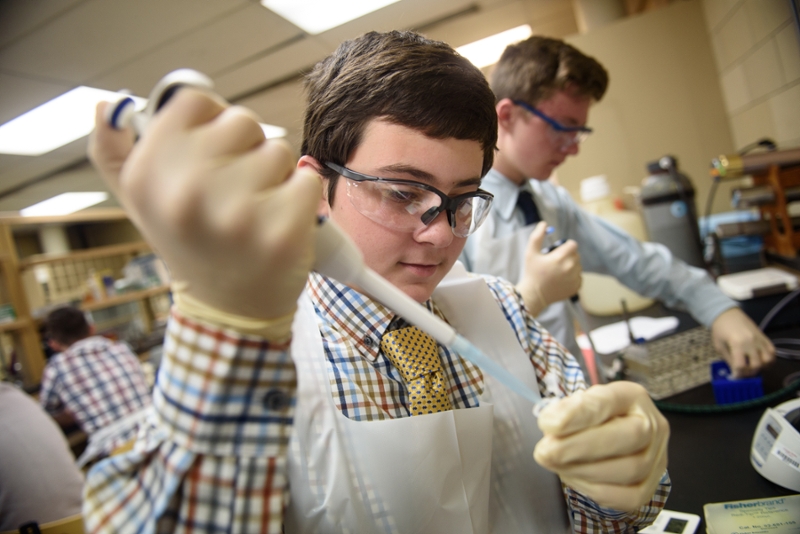
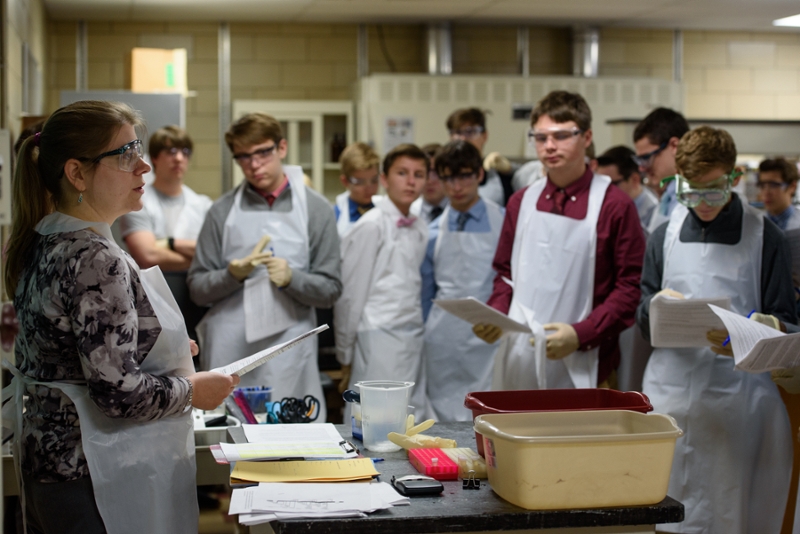
On November 6th and 7th, 2017, the Department of Biological Sciences Outreach Program hosted 120 high school students to perform a Molecular Biology Transformation Experiment. Students came from North Allegheny, Freeport, Central Catholic, Serra Catholic, and Ellwood City High Schools. Students were given an introduction into the central dogma of molecular biology, transformation, plasmid DNA structure, and the power of genetic engineering by Dr. Natalie McGuier. The students were then broken into smaller groups to carry out the experiment. The high school students were mentored by undergraduate and graduate teaching assistants from MCS.
Students were instructed on sterile lab technique before working at the lab bench. The students performed a transformation experiment where they made bacterial cells competent through an incubation in calcium chloride. Next, they transformed their competent bacteria with a control plasmid and plasmid pLUX (containing the luciferase gene from the marine fish, Vibrio fisheri.) After a recovery period, the plasmid-transformed bacterial cells were spread on agar plates. The day ended with the lead instructors reviewing the transformation experiment, and discussing the experimental outcomes. The students transported their agar plates back to their school for analysis. In the next days, the students assessed the pLux plasmid transformed bacteria for glow in the dark colonies.
Dr. Carrie Doonan coordinated the experiment. Dr. McGuier provided the Introductory Lecture. Lead Instructors were Dr. Maggie Braun, Dr. Lynley Doonan, Dr. Emily Drill, and Dr. Natalie McGuier. Undergraduate MCS teaching assistants were: Meredith Schmehl, Fred Mun, Alan Hsu, Kyle Gheewala, Madalyn Arcurio, Nina Edwards, Njaire McKoy, Madeleine Hyde, Brenda Xiao, Lucine Gabriel, Kaily Bruch, Allison Chu, Michael Young, Roosha Mandal, Theodore Warner, Jeffrey Beyon, Hunter Kready, Ruchi Asthana, Silvia Giampapa, Jessica Li, Linhong Li, Kathryn Hanson, Hyun Park, Meera Krishna, Sarah Klotz, Pedro Safi, Kiran Mirpuri, Apeksha Atal, Ruhani Mumick, Wonhee Han, Rahin Chowdhury, Ona Ichoku, Maxwell Martin, Julia Carter. Biology Graduate Student Teaching Assistants were: Ian Fucci, Iris Yang, Daniel Wilson, Katie Lagree, Roni Lahr. Participating High School teachers were Cara DeSalvo, Serra Catholic, Will Malokay, Freeport, Sherri Fowler, North Allegheny, Jonica Walters and Jody Christopher, Ellwood City, and Cassandra Sirockman - Bell, Oakland Catholic.
View more photos from the event on our departmental Flickr.
Making Glow in the Dark Bacteria
March 2017
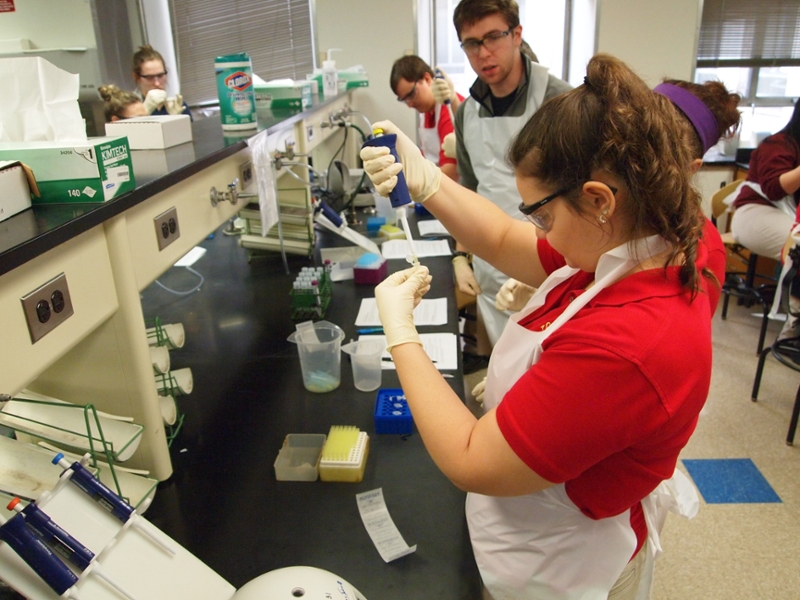
On March 21st and 22nd, 2017, the Department of Biological Sciences Outreach Program hosted 107 high school students to perform a Molecular Biology Transformation Experiment. Students came from North Allegheny, Freeport, Central Catholic, Serra Catholic, and Ellwood City High Schools and were given an introduction into the central dogma of molecular biology, Transformation, and Plasmid DNA structure, and the power of genetic engineering by Dr. Natalie McGuier. The students were then broken into smaller groups that were mentored by undergraduate teaching assistants.
Students were instructed on sterile lab technique before working at the lab bench. The students performed a transformation experiment where they made bacterial cells competent through an incubation in calcium chloride. Next, they transformed their competent bacteria with a control plasmid and plasmid pLUX (containing the luciferase gene from the marine fish, Vibrio fisheri.) After a recovery period, the plasmid-transformed bacterial cells were spread on agar plates. The day ended with the lead instructors reviewing the transformation experiment, and discussing the experimental outcomes. The students transported their agar plates back to their school for analysis. In the next days, the students assessed the pLux plasmid transformed bacteria for glow in the dark colonies.
Dr. Carrie Doonan coordinated the experiment. Dr. McGuier provided the introduction, and facilitated the outreach. Lead Instructors were Dr. Emily Drill, and Dr. Natalie McGuier. Undergraduate teaching assistants: Jennifer Huang, Njaire McKoy, Daniel Evans, Ansley Sharna, Emery Noll, Nathalie Chen, Hannah Soltz, Zach Sachar, Joe Park, Ian Foo, Hannah Kolev, Tanya Talwar, Miwa Shirai, Meredith Schmehl, Vanessa Diaz, Tiffany Phan, Phillip Nantawisarakul, Noa Park, Ling Xu, Kavita Ramnath, Fred Mun, Joe Garvey, Julia Carter, Erin Sipple, Jared McPhail, Carolyn Vanek, Jacob Muskovitz, Alan Hsu, Kyle Gheewala, Amanda Kuhn, Kathy Huang, and Jamie Yang. Participating High School teachers were Cara DeSalvo, Serra Catholic, Will Malokay, Freeport, Sherri Fowler, North Allegheny, Jonica Walters and Jody Christophe, Ellwood City, and Cassandra Sirockman - Bell, Oakland Catholic.
Quantitating Protein Content in Food
March 2016
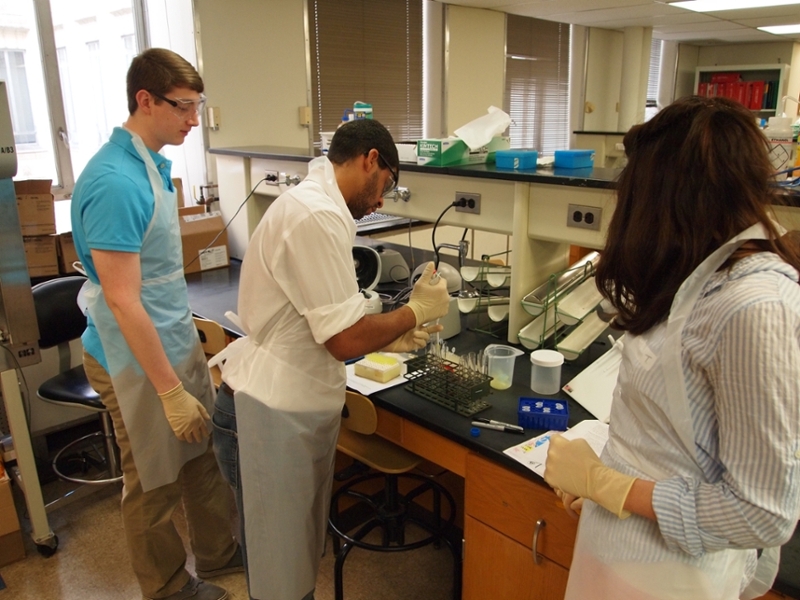
On March 15th and 16th, 2016, the Department of Biological Sciences Outreach Program hosted 95 high school students to design a project to determine the quantity of protein in a variety of food items. Students came from North Allegheny, Freeport, Central Catholic, Serra Catholic, and Oakland Catholic High Schools and were given an introduction into the central dogma of molecular biology, protein structure, and current methods to detect protein by Zara Weinberg. The students were then broken into small groups and asked to design a project and formulate a hypothesis about the protein content in food items that were available for their testing. Students were actively engaged in their projects – and some even designed their project based off of foods they commonly eat.
After having formulated a hypothesis, the students used the Bradford Assay to determine the concentration of protein in their samples. The Bradford Assay is a biochemical technique that utilized a specific dye that changes color upon interaction with protein molecules. This color change can be quantitatively measured with the use of a spectrophotometer. Students generated a standard curve with known concentrations of proteins and then used this to determine the concentration of their samples. The day ended with each group giving a presentation explaining their hypothesis, results, and insights into their projects.
Dr. Carrie Doonan coordinated the experiment. Lead Instructors included Dr. Emily Drill, Dr.Natalie McGuier, and Dr. Becki Campanaro. Graduate student Zach Weinberg introduced the students to the topics and also served as a teaching assistant. Other Graduate teaching assistants included: Ceren Tuzmen, Shanna Bowman, Amanda Willard, Scott Keith, Elena Shueva, Surya Aggarwal, Dan Wilson, and Ruchi Asthana. Undergraduate teaching assistants: Jennifer Huang, Donna Lee, Hannah Rhee, Erin Fingleton, Minnah Ahn, Alex Lewis, Jamie Zahn, Ian Foo, Shaun Ranaude, Michelle Yu, Charlotte Darby, Tiffany Phan, Joe Park, Rene Francolini, Amanda Kuhn, Kahty Huang, Susheel Kheterpal, Wendy Du, Sophia Weinbar, Miwa Shira, Hannah Kolev, and Philip Nantawisarakul. Participating High School teachers were Cara DeSalvo, Serra Catholic, Bill Malokay, Freeport, Melissa Franks, Oakland Catholic, Sherri Fowler, North Allegheny, and Cassandra Sirockman-Bell, Oakland Catholic.
Quantitating Protein Content in Food
March 2015
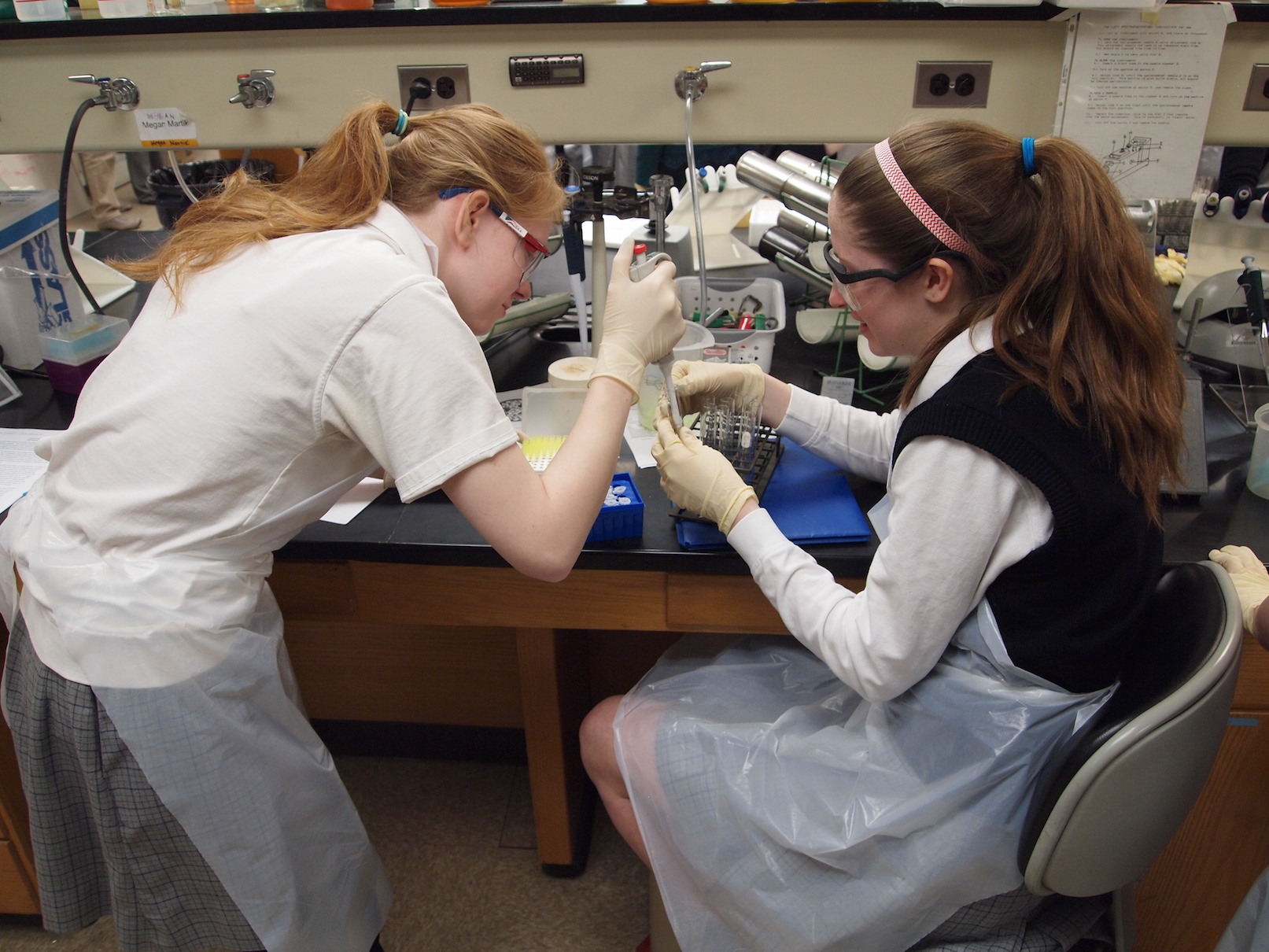
On March 18th and 24th, 2015, the Department of Biological Sciences Outreach Program hosted 60 high school students to design a project to determine the quantity of protein in a variety of food items. Students came from Bishop Canavin, Ellwood City, Serra Catholic, and Oakland Catholic High Schools and were given an introduction into the central dogma of molecular biology, protein structure, and current methods to detect protein. The students were then broken into small groups and asked to design a project and formulate a hypothesis about the protein content in food items that were available for their testing. Students were actively engaged in their projects – and some even designed their project based off of foods they commonly eat.
After having formulated a hypothesis, the students used the Bradford Assay to determine the concentration of protein in their samples. The Bradford Assay is a biochemical technique that utilized a specific dye that changes color upon interaction with protein molecules. This color change can be quantitatively measured with the use of a spectrophotometer. Students generated a standard curve with known concentrations of proteins and then used this to determine the concentration of their samples. The day ended with each group giving a presentation explaining their hypothesis, results, and insights into their projects.
Dr. Carrie Doonan and Nathan Wilson coordinated and developed the experiment. Lead Instructors included Dr. Emily Drill, Dr. Swarna Mohan, and Nathan Wilson. Graduate student Zach Weinberg introduced the students to the topics and also served as a teaching assistant. Other Graduate teaching assistant included: Amanda Soohoo, Vinitha Ganesan, Lynley Doonan, Berquin Feese, Shanna Bowman, Andy Kehr, and Berryhill McCarty. Undergraduate teaching assistants: Raghu Avula, Rachel Willen, Yemi Bankole, Nikita Mishra, Kaitlin Hamilton, Jamie Zhan, Katie Krasikova, Serena Zhou, Danielle Peters, Amanda Broderick, Nicole Matamala, and Bridget Hunt-Tobey were instrumental to the success of the day. Participating High School teachers were Cara DeSalvo, Serra Catholic, Vanessa Bentley, Bishop Canevin, Jonical Walters, Ellwood City and Cassandra Sirockman, Oakland Catholic.
Simulating a Disease Outbreak
April 2014
Twenty-five students from Oakland and Central Catholic high schools visited in April to see how disease outbreaks can be detected and tracked using an ELISA. Teachers Mark Krotec (Central Catholic) and Melissa Franks (Oakland Catholic) were also in company.
An Enzyme Linked Immunosorbent Assay (ELISA) is a common biochemical technique that is used to detect substances with a high degree of sensitivity. It is commonly used in the field of epidemiology to trace the path of disease outbreaks. At the core of the method, an ELISA relies on the specificity of antibodies. When the immune system encounters a foreign substance, antibodies are produced specifically for that substance. The subsequently produced antibody then binds to the foreign substance (called an antigen). The antigen-antibody specificity is how an ELISA can determine the presence of an antigen with such specificity.
In this module, students simulated a disease outbreak by sharing tubes of simulated bodily fluids. After several rounds of sharing, each student performed an ELISA on their sample to determine whether or not they had been exposed. At the end of the experiment, students amassed all their data and went to work back-tracking the spread of the “disease”.
Dr. Carrie Doonan coordinated the event. Dr. Swarna Mohan served as lead instructor while Nathan Wilson, Joseph Doonan, and graduate student Christopher Pratt were teaching assistants for the event.
Biological Techniques: ELISA, immunology, antibodies
Determining the Danger of Secondhand Smoke
March 2014
The Department of Biological Sciences hosted 63 students from Bishop Canevin, Serra Catholic, Ringgold, and McKeesport high schools on March 18, 19, 25 and 26th. This outreach program stressed the importance of knowing the dangers of secondhand smoke exposure, as well as gave the students the opportunity to develop their own experimental design and ownership of data in the life sciences. The students were accompanied by their teachers: Sara Brown (Ringgold), Cara DeSalvo (Serra Catholic), Joan Smith (McKeesport), and Vanessa Bentley (Bishop Canevin).
In recent decades, the dangers of smoking and secondhand smoke have come to light. It is common knowledge that smoking and secondhand smoke have detrimental health effects on most living organisms. Students learned the uses of model organisms in biology, specifically the uses of Baker’s yeast S. cerevisiae. Based off of what they had learned about both secondhand smoke and model organisms, students were tasked with designing an experiment that would demonstrate the dangers of secondhand smoke.
On the first day, students were given a culture of wild type S. cerevisiae and were given a primer of basic microbiology and the culturing of yeast. Students then designed exposure chambers and variable they wanted to test. Groups had their choice of many variables to test, examples include: exposure time, distance, cigar/cigarette brand, etc. Once the choice of cigar/cigarette brand was chosen, yeast were spread on agar plates and inserted into the student built smoking chambers. With the aid of the teaching assistant, students exposed their yeast according to their experimental design.
Once the yeast had some time to grow the students returned a second day, analyzed the data, created killing curves, and prepared a short seminar-style talk. After their presentations, students also had the chance to go to the microscopy lab, and compare and analyze the differences in lung tissues of a smoker vs. a nonsmoker.
The outreach was possible due to the undergraduate, graduate, and alumni research mentors. Graduate student and alumni volunteers were: Andrew Kehr, Olivia Molinar, Ian Bayles, Joseph Doonan, Stacey Kuzetsov, Ming Zhang, and Vishnu Chandra. Undergraduate mentors were: Alexis Oguh, Eric Pederson, Dustin Brout, Kaitlin Hamilton, Jacob Krause, Tara Sheikh, Emma Hartman, Corrina Tender, Patricia Thang, Victor Bass, Elizabeth Berryhill McCarty, Alexander Post, Yemi Bankole, Memphis Hill, Dallas Hartman, Serena Zhou, Marlena Darr, and Brian Mattes.
Dr. Carrie Doonan coordinated and ran the event. Dr. Swarna Mohan and Nathan Wilson were instructors for the event. Graduate student Andrew Kehr was a lead instructor.
Biological Techniques: Experimental design, microbiological growth, data analysis, Second hand smoke, killing curves, Growth of S. cerevisiae.
Exploring Gene Regulation
November 2013
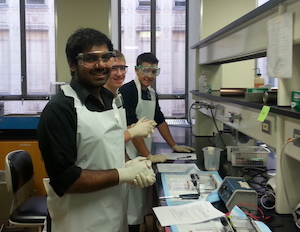
This fall 61 high school students and 32 Biology undergraduate and graduate students participated in the Biological Sciences outreach event that focused on Cancer. The students explored the role that genetics plays in the development of cancer.
Once understanding that there are two key types of genetic errors in cancer: the gain of oncogenes and the loss of tumor suppressor genes, students were able to focus on the role that the well-studied tumor protein 53 (p53) has in cancer. Students analyzed a patient’s DNA for the region coding for p53. The DNA was previously digested with restriction enzymes that recognized sequences specific to common, “hot spot”, mutations. This patient was also implicated as having Li-Fraumeni syndrome, a rare, inheritable condition that greatly increases the likelihood of cancer. Students then had to construct the story of the DNA they were analyzing and create a family pedigree to check for the patterns indicative of Li-Fraumeni.
Additionally, students had the opportunity to visually compare cancer cells and healthy cells under a microscope. Special emphasis was put on the contrast in morphology between both types of cells.
Students from Ellwood City, Oakland Catholic, Ringgold, and Serra Catholic High Schools accompanied their teachers: Jonica Walters (Ellwood City), Melissa Franks (Oakland Catholic), Sara Brown (Ringgold), and Cara DeSalvo (Serra Catholic).
The outreach was accompanied by a great turnout from volunteer biology undergraduate and graduate students from the teaching club serving as teaching assistants, acting as both mentor and guide through the scientific process. The graduate assistants included: Christopher Pratt, Emily Simon, Idil Ulengin, Shanna Bowersox, Dylan McCreary. The undergraduate assistants included: Alexander Chen, Alexis Oguh, Corrina Tender, Lazar Lalone, Patricia Thang, Tiffany Zhu, Raghu Avula, Rachel Sewell, Christine Zhang, Xander Orenstein, Marlena Darr, Isaac Shamie, Filip Istvanic, Paige Davison, Kaitlin Hamilton, Abimbola Bankole, Angela Yi, Alexander Post, Victor Bass, Mark Nicholas, Yimeng Xu, Tara Sheikh, Serena Zhou, and Dustin Brout.
Dr. Carrie Doonan coordinated and led the event. Dr. Swarna Mohan, and Nathan Wilson were instructors for the event. Lead graduate instructors were Andrew Kehr, Amanda Soohoo, and Ming Zhang. Undergraduate instructor was Memphis Hill.
Biological Techniques: Agarose Gel Electrophoresis, Restriction Enzyme Digests, Cancer Biology, Morphology of Cancer Cells, Pedigree Analysis
Exploring Gene Regulation
December 2012
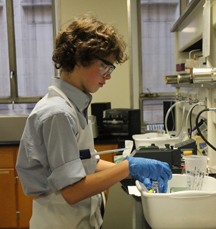
Fifty students from Serra Catholic, Ringgold, Bishop Canevin, and Ellwood City High Schools, along with their teachers Cara DeSalvo (Serra Catholic), Sarah Brown (Ringgold), Peggy Evans (Bishop Canevin), and Jonica Walters (Ellwood City) explored gene regulation at a recent Department of Biological Sciences outreach event.
Using the knowledge that bacteria cells, such as E. coli, use glucose as a carbon source and that the enzyme, β-galactosidase, aids in the conversion of disaccharide lactose to glucose and galactose monomers, the students monitored two bacterial cultures and removed samples at regular intervals to assay for β-galactosidase. Then, students predicted and observed the effect of different sugars on the intercellular levels of β-galactosidase using orthophenolnitrate as a substrate. When present, β-galactosidase will cleave the bond in orthophenolnitrate resulting in two products, galactose and nitro-phenol. Students used a spectrophotometer to measure the amount of nitro-phenol via absorbance. Therefore, the students demonstrated that certain small sugar molecules regulate the expression of E. coli’s lactose genes.
Biology undergraduate and graduate students served as teaching assistants and guided participants through the experiment. The graduate students were Andy Kehr, Ming Zhang, Idil Ulegin, and Yi Wang. The undergraduates included Joe Defazio, Darren Morris, Erica Moore, Tam Minh Le, Katie Supko, Rachel Sewell, Nick Zuniga, Alex Rodriguez, Marianne Pan, Lindsey Fong, Kelly Shibuya, Amy Li, David Vinson, and Patricia Thang.
Additionally, Drs. Carrie Doonan and Emily Drill coordinated everything on the day of the event, while Sara Blankenship completed the earlier organization. Other departmental personnel and volunteers included Dr. Maggie Braun and Barry Harris.
Biological Techniques: Spectrophotometry, enzymatic assay, bacterial growth
Research Mentoring Project
November 2012
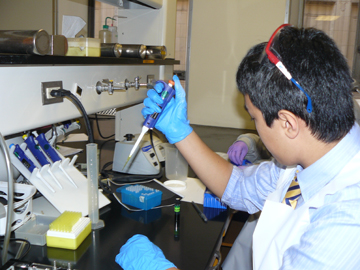
The Department of Biological Sciences Outreach program piloted a new outreach project this November designed to provide area high school students the chance to design and carry out a research project. Twenty-two students enrolled in Biology at Central Catholic and Oakland Catholic high schools as well as teachers Eric Dunkerley (Central Catholic) and Melissa Franks (Oakland Catholic) participated in this three - week long program in the Undergraduate Biology laboratories. Students were paired with an undergraduate or graduate Biology student mentor, who acted as their advisor for the project. The project was to investigate the biotechnology in genetically engineered foods.
One of the greatest achievements of genetic engineers has been the creation of genetically modified organisms (GMO’s). The genomes of such organisms have been changed or adapted in ways that can increase crop yield, raise nutritional value, and even decrease fat content in livestock. Many food products, especially processed foods, contain GMO’s unless clearly labeled as organic. Corn and soy are the most commonly modified ingredients. Products labeled as ‘Natural’ are not necessary GMO free as FDA guidelines for this term are not as strict as for organic labels. One way to test for genetic modification is by identifying the presence of a cassette. Cassettes are segments of DNA containing a promoter, gene of interest, and a terminator which are inserted into an organism’s genome. A gene of interest for example may confer bacterial resistance or increase crop yield. Most plants modified in this way, 90% of the time, use CAMV35S or the cauliflower mosaic virus, as the promoter because it is easily incorporated into the host genome. This allows one to test for genetic modifications based on the presence of the CAMV35S promoter. Students planned a research project to determine whether various foods such as cereal, chocolate, peanut butter, tortilla chips, and power bars were made using modified corn or soy. Some chose to confirm that organically labeled foods were truly organic. First, students isolated DNA from food samples and then performed Polymerase Chain Reaction (PCR) on the sample using primers for the CAMV35S promoter region. By performing PCR, students were able to amplify the amount of DNA containing the modified promoter. Primers specific to this region ensured that only the promoter, if present, would be amplified. With the help of their mentors, students then performed agarose gel electrophoresis. In addition to their PCR samples, students also loaded positive and negative controls as well as a molecular weight marker of known sizes. Students and mentors worked as a team in analyzing results. Students presented a their results in a formal presentation on November 13. Dr. Amy Burkert, Vice Provost for Education, welcomed the students, mentors, parents and principles and provided an introduction for the research seminars. Through this program, high school students had this unique opportunity to perform a continuous research experiment under the guidance of their teaching assistant. The undergraduate and graduate students gained teaching experience through their interactions with the students.
Undergraduate mentors were Tom Miller, Rachel Sewell, Marianne Pan, Xuexia Jiang, Sherry Chiang, Catherine Byrd, Naomi Gunawardena, Semawit Gebrehiwot, Victor Bass, Nick Zuniga, Darren Morris, Kayla Zamora, Kelly Shibuya, and Alex Rodriguez. Graduate students and alumni included Andy Kehr, Ming Zhang, Sheila Chandran, and So Jung Lee. The event was planned and run by Dr. Carrie Doonan. Sara Blankenship helped coordinate the event.
Biological Techniques: DNA Isolation, PCR, agarose gel electrophoresis
Murder Mystery
October 10, 2012
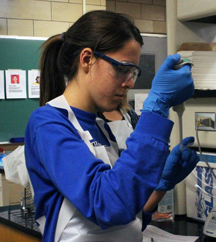
On October 10, the Department of Biological Sciences hosted an outreach event for area high school students. The event was attended by 55 students from Serra Catholic, Ringgold, Bishop Canevin, and Ellwood City High Schools, along with their teachers Cara DeSalvo (Serra Catholic), Sarah Brown (Ringgold), Peggy Evans (Bishop Canevin), and Jonica Walters (Ellwood City).
The high school students were transformed into forensic scientist for the day by solving a murder mystery with DNA fingerprinting technology. The human genome has regions of repetitive DNA sequences known as Variable Number of Tandem Repeats (VNTR). The number of repeats and the location varies between individuals. Since the DNA fingerprint is so unique to each individual, students were able to compare “crime scene DNA” to known “suspect DNA”, and solve the crime. Purified plasmid DNA was used as the crime scene DNA. Prior to creating the DNA fingerprint, restriction enzymes were used to determine the VNTR. This created a highly specific pattern of DNA and the DNA fragments were then analyzed by agarose gel electrophoresis.
Numerous undergraduate and graduate students served as teaching assistants and guided the high school students through the experiment. The following graduate students assisted with the event: Emily Furbee, Andy Kehr, Ming Zhang, Alys Cheatle, and Yi Wang. The undergraduates involved included Kayla Zamora, Laura Filliger, Joe Defazio, Michael Platov, Darren Morris, Erica Moore, Tam Minh Le, Katie Supko, Rachel Sewell, So Jung Lee, Nick Zuniga, Vishnu Chandra, Alex Rodriguez, Lauren Williams, Marianne Pan, Alex Chen, Danielle Peters, Jimmy Shak, Mark Nicholas, and Stephanie Hare.
Additionally, Dr. Carrie Doonan and Sara Blankenship organized the event. Dr. Emily Drill, Dr. Annette Vincent, Mr. Barry Harris and Lynley Doonan were lead instructors for the event. Anther departmental participant in the outreach event was Trina Goggins.
Biological Techniques: Restriction enzyme digestion, agarose gel electrophoresis
Scavenger Hunt
Summer 2012
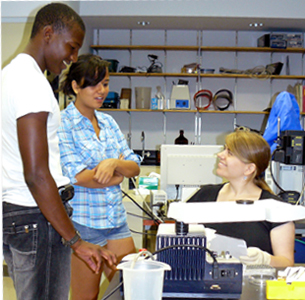
The Department of Biological Sciences hosted a science scavenger hunt outreach event for high school students in Carnegie Mellon University’s Summer Academy for Math and Science (SAMS) and the AP Biology Summer Institute on July 20.
The scavenger hunt stations introduced the high school students to research through five-to-ten minute talks or demonstrations summarizing the research projects of HHMI-Summer Research Institute (SRI), CMU-Qatar or Summer Undergraduate Research Program (SURP) students. The talks or demonstrations topics included creating glow in the dark bacteria, computationally modeling neurons, training mice to play video games, and examining the structure of ribosomes. At the end of each station, the high school students had to answer questions before moving on. After visiting all of the stations, the students turned in a completed form for a cool treat.
This outreach would not have been possible without the help of numerous undergraduate students, including Hiba Al-Ashtal, Ridin Balakrishnan, Hailey Brown, Dagney Cooke, Elise Croteau-Chonka, Mei Elgindi, Hadya Elshakh, Susan Hannes, Naomi Gunawardena, Chelsea Hoffman, Kacey Idouchi, Sean Kane, Raji Katibe, Annette Ko, Ben Kuo, Lazar LaLone, Jessika Louissaint, Andrew McCoy, Mridula Nadamuni, Gordon Pherribo, Abigail Simmons, Daniel Sori, Nick Teslovich, and Sowmya Yennam.
Department of Biological Sciences members, Dr. Carrie Doonan and Sara Blankenship, coordinated the event, while Drs. Emily Drill and Annette Vincent presented their research to students. Also, Ms. Ronni Rossman, the AP Biology Summer Institute teacher, participated.
ELISA
Spring 2012
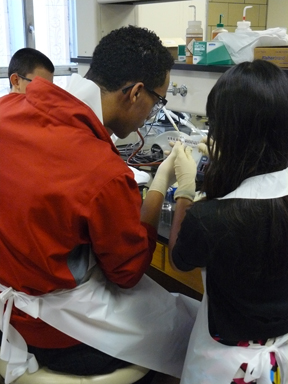
The tradition of excellence in outreach continued this spring as the Department of Biological Sciences hosted an outreach event for area high school students. In total, eighty-five students from Serra Catholic, Bishop Canevin, Ringgold, Barack Obama Academy of International Studies, and Ellwood City high schools attended the event along with their teachers, Cara DeSalvo (Serra Catholic), Peggy Evans (Bishop Canevin), Lara Panseri (Ringgold), Ronni Rossman (Barack Obama Academy of International Studies), and Jonica Walters (Ellwood City).
The topic of this outreach was how ELISA (Enzyme Linked Immunosorbent Assay) assays are used to detect and track a disease outbreak. In response to infectious agents such as viruses, bacteria, and fungi, also known as an antigen, invading the body, the immune system begins producing antibodies. These small proteins are extremely specific and recognize then bind to the foreign antigen. Antigen-Antibody specificity is the basis for the ELISA technique. The reaction produces a visible color which indicates the presence of the antigen. Through a simulation, students created a disease outbreak by sharing samples of simulated bodily fluids. They then performed an ELISA assay on their final samples to determine if they had been exposed to the disease. At the end of the day, students meet in groups to compile the results and determine which samples initially contained the disease antigen.
Dr. Emily Drill lead students through an exercise designed to show how antibodies are used in research, specifically using immunohistochemistry to identify different cell types. Students examined prepared slides of mouse brain sections stained with antibodies under a compound light microscope. Slides were stained with a wide array of antibodies, allowing them to compare different neuron populations based on labeling patterns.
Students also learned how antibodies and other components of blood serum can be used to trace evolutionary relationships in an activity provided by Mr. Mark Krotec. In a simulation, synthetic rabbit serum is mixed with synthetic human serum. The rabbit serum will produce antibodies which causes precipitation of serum components. The amount of precipitation correlates with the degree of evolutionary relationship. Students were able to determine the evolutionary relationships.
Numerous undergraduate and graduate students served as teaching assistants and guided the high school students through the experiment. The following graduate students assisted with the event: Merissa Remus, Karen Kormuth, Andrew Kehr, Nina Senutovich, Shanna Bowersox, and Maria McDonald. The undergraduates involved include: Ajay Patal, Chelsea Hoffman, So Jung Lee, Meg Libonati, Eric Pederson, Nadia Sheen, Jennifer Nam, Oliver Ruiz, Rachel Shaffer, Kaitlin Healy, Chelsea Weber, Danielle Devine, Ben Kuo, Madeline Rosnick, Maria Kobidze, Laura Filliger, Nick Teslovich, Priyanka Nandakumar, Susan Hannes, Titas Banerjee, and Maneesha Sakhuja. The lead undergraduate teaching assistants were Medini Annavajhala, Ian Campbell, Minju Kim, and Adam Sinder.
Drs. Carrie Doonan and Emily Drill coordinated the event. Other departmental, alumni and university personnel who participated in the outreach event were Mark Krotec, Barry Haris and Melissa Witzberger.
Biological Techniques: Immunology, ELISA, Compound light microscopy
DNA Mutations
December 15, 2011
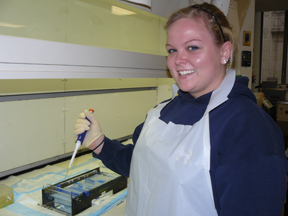
On December 15, the Department of Biological Sciences, the Sciences Teaching Club and the Biological Sciences Student Advisory Council (BioSAC) hosted an outreach event for area high school students. The event was attended by sixty- seven students from Serra Catholic, Ringgold, Perry and Ellwood City High Schools, along with their teachers Cara DeSalvo (Serra Catholic), Barry Harris (Ringgold), Ronni Rosman (Perry) and Jonica Walters (Ellwood City).
The goal of the event was to teach students about DNA mutations and how restriction enzymes can be used to characterize them. Students learned about various types of mutation by studying the differences between normal and mutant DNA of the β globin gene. In this experiment, the mutation in the β globin is the cause of β Thalassemia. To identify whether the disease state was caused by an insertion, deletion, or point mutation, students performed a restriction digest on both β globin DNA samples which were then loaded onto an agarose gel for separation. Students then visualized the DNA fragments on a gel imager. At the end of the day, students met in groups with the teaching assistants to determine the mutation type by comparing fragment length.
Numerous undergraduate and graduate students served as teaching assistants and guided the high school students through the experiment. The following graduate students assisted with the event: Emily Furbee, Merissa Remus, Maureen Stolzer, Chris Williams and Ardon Shorr. The undergraduates involved include: Lindsey Fong, Ajay Patal, Chelsea Hoffman, Terri Jones, Minju Kim, So Jung Lee, Meg Libonati, Andrew McCoy, Eric Pederson, Katie Supko, Ian Bayles, Sherry He, Julia Lekht, Nadia Sheen, Jennifer Nam, Oliver Ruiz, Anna Park, Rachel Shaffer,Greg Lin, Kishore Jayakumar, Kaitlin Healy, Janice Lyu, Kelly Shibuya, Judy Savitskaya, So Jung Lee, and Dachan Kwon. The lead undergraduate teaching assistants were Medini Annavajhala, Ian Campbell, Lianne Cohen and Stephanie Guerra.
Additionally, Drs. Carrie Doonan, Maggie Braun and Nina DiPrimio coordinated the event, while Sara Blankenship completed the earlier organization of the event.
Biological Techniques: Restriction enzyme digestion, agarose gel electrophoresis, Wild Type, Point Mutation, Insertion and Deletions.
Making Glow in the Dark Bacteria
November 8, 2011

Seventy-eight students from Serra Catholic, Ringgold, Perry and Ellwood City High Schools, along with their teachers Cara DeSalvo (Serra Catholic), Barry Harris (Ringgold), Ronni Rosman (Perry) and Jonica Walters (Ellwood City), attended an outreach event hosted by the Department of Biological Sciences, the Sciences Teaching Club and the Biological Sciences Student Advisory Council (BioSAC).
At the event, the students performed the experiment “Making Glow in the Dark Bacteria,” which fulfills a requirement in the AP biology curriculum. The experiment involved transforming E. coli with a plasmid containing the Lux gene from Vibrio fisheri. As a result, the bacteria that took up this plasmid glowed in the dark. At the end of the day, students transported agar plates with the transformed bacteria to their high schools to incubate for twenty-four hours. The students will analyze their results in their respective high school classrooms.
Numerous undergraduate and graduate students served as teaching assistants and guided the high school students through the experiment. The following graduate students assisted with the event: Jineta Banerjee, Alys Cheatle, Emily Furbee, Andrew Kehr, Cass Priddy and Suchitra Ramachandran. The undergraduates involved include: Rob Alberstein, Titas Banerjee, Joseph DeFazio, Danielle Divine, Alex Doonan, Lindsey Fong, Semawit Gebrehiwot, Stephanie Guerra, Naomig Gunawardena, Susan Hannes, Chelsea Hoffman, Sara Hoge, Isabel Hubbard, Terri Jones, Justine Kim, Minju Kim, Maria Kobidze, So Jung Lee, Amy Li, Wendy Li, Meg Libonati, Andrew McCoy, Tom Miller, Priyanka Nandakumar, Marianne Pan, Jesse Payton, Eric Pederson, Preri Reddy, Oliver Ruiz, Katie Supko and Chelsea Weber. The lead undergraduate teaching assistants were Medini Annavajhala, Ian Campbell, Lianne Cohen and Ajay Patel.
Additionally, Drs. Carrie Doonan and Nina DiPrimio coordinated everything on the day of the event, while Sara Blankenship completed the earlier organization of the event. Other departmental, alumni and university personnel who participated in the outreach event were Melissa Krajcovic, Maureen Stolzer, Diane Turnshek, and Chris Williams.
Biological Techniques: Transformation, Biotechnology and Genetics of Plasmids.
Dr. Carrie Doonan Receives 2011 Mark Gelfand Service Award for Educational Outreach
Carrie Doonan was educated at Chatham College (BS) and the University of Connecticut, (Ph.D) and began her teaching career at Carnegie Mellon University in 1993. Carrie is a Teaching Professor in the Department of Biological Sciences and Director of Undergraduate Laboratories. Her primary area of focus involves the teaching and administration of a range of experimental laboratories in the department. She is responsible for writing and developing experimental units, training of junior faculty and teaching assistants and is actively involved in all aspects of the undergraduate program. She has adapted many of her curricular innovations for use in K-12 outreach and has been invited to present this work at regional and national forums. She served as a Biotechnology Institute National Biotechnology Teacher-Leader in 2003 and 2005 and was awarded the Julius Ashkin Teaching Award in the Mellon College of Science in 2000.
To read the complete article, visit: http://www.cmu.edu/celebration-of-education/gelfand-award/
PJAS and Secondary Science Academy Workshops
September 24, 2011
A transformation experiment was performed with 15 students using bioluminescence genes of Vibrio fisheri. Students performed a transformation experiment where they transform E. coli with a plasmid containing the Lux gene from Vibrio fisheri. The bacteria that take up this plasmid glow in the dark.
Carrie Doonan taught the workshop, with undergraduates Lianne Cohen, Ian Campbell, Medini Annajhavala, and Minju Kim.
Biological Techniques: Transformation.
September 17, 2011
Saturday morning workshops for both PJAS (Pennsylvania Junior Academy of Science). Eighteen High school students come into the lab on Saturday mornings and perform the experiment, Turning Genes On and Off. In this experiment, students measure the induction of the Lac operon in E. coli by quantitation of the enzyme b–galactosidase. Twenty High school students participated in this workshop. Carrie Doonan taught the workshop, with undergraduates Anna Park, Medini Annajhavala, and Minju Kim.
Biological Techniques: Induction of the lac operon, Beta-galactosidase protein measurement.
Protein Day
May 5, 2011
Protein Day was held at Carnegie Mellon where 65 High School Students from Serra Catholic, Ringgold and Peabody high School learned about proteins. The day was split into three activities, where students learned about antibodies and how they function from Dr. Nina DiPrimio, next they learned about Protein Isolation using column chromatography from undergraduates Priyamvada Gupta and Mike Khan, next they leaned about disease outbreaks from doing an elisa experiment from Lynley Doonan and Sandy Roh. The end of the finished with a discussion of protein structure and function.
Undergraduate Tas were Adam Sinder, Kelsey Murray, Derek Lee, Amy Wang, Ajay Patel, Minju Kim, Andrew Medenbach, Archana Ramgopal, Ester Lee, Oliver Ruiz, Lianne Cohen, Ian Campell, Janice Lyu, Ali Aunkst, Madeline Rosnick, Hanna Choi, and Sara Ackermann and Kaitlin Healy.
CMU Faculty were Carrie Doonan, Nina DiPrimio, and Ken Hovis.
Biological Techniques: Protein isolation and purification, Elisa protein assay, column chromatography and Antibody structure and function.
Department Hosts Science Outreach Event for Middle School Students
July 22 & 23, 2010
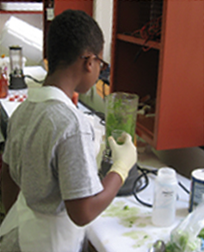
On July 22 and 23, thirty-four students and mentors from the Mount Ararat Baptist Church Community Activity Center (MACAC) visited the Mellon Institute for an outreach event hosted by the Department of Biological Sciences. During the event, the group solved a mock murder mystery by evaluating DNA samples extracted from different fruits and vegetables using water, dish detergent and salt. Standard molecular biology techniques were utilized to digest the different DNA samples with restriction enzymes and analyze the digested samples on agarose gels. In the process, students learned how to safely use different laboratory equipment and reagents.
Dr. Carrie Doonan designed the event, while numerous undergraduate researchers led the instruction.
MACAC‘s mentoring groups work with middle school students to augment their academic and social skills, thereby helping them achieve their goals.
Written by:
Megha Kapur
Undergraduate TAs were Mike Khan, Lynley Doonan, Jane Lew, Andre Hersan, Lianne Cohen, David Huang, Josh Plotnik, Katie Griswold, Sefa Kploanyi
Biological Techniques: DNA extraction, restriction enzyme digests, Agarose gel electrophoresis.
Scavenger Hunt Outreach Event with High School Students
July 22, 2010
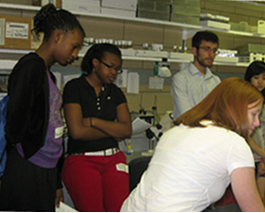
On July 21, thirteen ninth-grade students and four teachers from Westinghouse High School, located in Pittsburgh’s Homewood community, participated in a science scavenger hunt hosted by the Department of Biological Sciences.
During the hunt, the group toured nine laboratories, which conduct research in various areas of biology. At each stop, departmental staff, graduate students and undergraduate researchers gave demonstrations of experiments and techniques. Each demonstration contained an answer in the scavenger hunt.
At Macbeth Lab, the students met with Andre Hersan, a Howard Hughes Medical Institute (HHMI) undergraduate researcher, who showed them 3D X-ray crystal structures of proteins and tools used to generate them. The group learned about Western Blotting, a technique used to analyze and detect specific proteins using antibodies, when visiting undergraduate, Mike Khan, in the Rule Lab. Over in the Minden Lab, fifth-year graduate student Melissa Krajcovic discussed the different stages of the life cycle of the fruit fly.
Teaching Professor Carrie Doonan coordinated the visit and four other HHMI undergraduate researchers gave demonstrations, Lynley Doonan (Woolford Lab), David Huang (Mitchell Lab), Sefa Kploanyi (Macbeth Lab), Shriya Venkatesh (McCartney Lab). In addition, staff researcher Andrea Zonneveld (Lopez Lab) and students in the Summer Research Institute program helped out with the event.
Written by:
Megha Kapur
Biological Techniques: DNA extraction, restriction enzyme digests, Agarose gel electrophoresis, protein purification, genetics and undergraduate research.
Diversity of the Ocean
December 2010 (2 sessions)
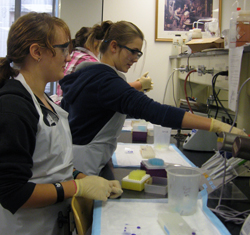
Around 30 Ringgold High School students had the opportunity to explore the diversity of life in the ocean, with Assistant Professor Veronica Hinman and members of the Hinman Laboratory. The National Science Foundation-sponsored outreach event taught the students how marine species, particularly invertebrate animals, are identified and grouped, how they develop, and how genetic variation can be studied. These are all essential components of understanding the diversity of life in the ocean and how it evolved.
The event began with the high school students observing adults and developing embryos of starfish and sea urchins, model systems for development and cell morphogenesis. Next, the students utilized microscopes to observe a diverse array of marine larvae and embryos in seawater Petri dishes, and to try their skills at photographing the larvae. Based upon their observations, the students selected larvae for DNA extraction and attempted to identify the species. The students were taught how to extract DNA and use a polymerase chain reaction (PCR) to amplify two regions on the 18s ribosomal gene. The 18s gene is very similar in different species; however, over time it slowly acquires mutations.
Back at school, the students were able to look at their sequences and use a variety of bioinformatics databases to explore more about the organisms that they had observed.
DNA Lab
December 8, 2010
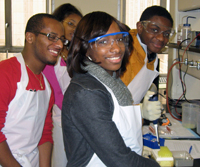
On December 7th, the Department of Biological Sciences hosted 55 advanced placement (AP) biology students from three local high schools for an outreach event that was truly unique -- it was taught completely by undergraduate students.
The biological sciences undergraduate instructors and mentors lead the high school students through the AP biology curriculum-required lab, DNA analysis using restriction enzymes and agarose gel electrophoresis. The day began with lectures from the undergraduate instructors on micropipetting, performing DNA restriction enzyme digests and agarose gel electrophoresis. Then, the high school students were placed into groups to complete the lab, which taught biology principles by working to solve a DNA murder mystery. Each group was overseen by an undergraduate mentor, resulting in more individualized attention.
“Our students can relate to these undergraduates, and as a result, learn more. [The high school students] have the unique opportunity to not only learn the biology, but also ask questions about college,” stated one of the high school teachers.
Dr. Carrie Doonan together with Drs. Maggie Braun and Nina DiPrimio coordinated the event.
The participating schools were Ringgold High School with AP biology teacher Barry Harris, Peabody High School with AP biology teacher Ronni Rossman and Serra Catholic with AP biology teacher Cara DeSalvo.
The undergraduate instructors were Jeff Dahlen, Lynley Doonan, Amy Fuller and Sang Ah Roh. The undergraduate mentors were Sarah Ackermann, Katherine Bonnington, Ian Campbell, Lianne Cohen, Trisha Dant, Alexandra Doonan, Siping He, Kellie Kravarik, Derek Lee, Yanting Liu, Kelsey Murray, Josh Plotnik, Shriya Venkatesh and Amy Wang.